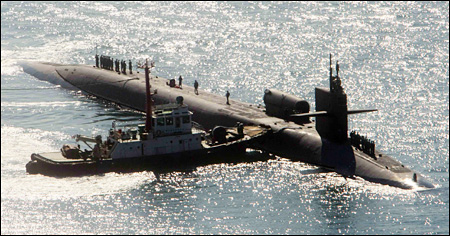ROK to take back wartime control in 2015 as planned

United States nuclear-powered submarine USS Ohio (SSGN 726) arrives in Busan, Wednesday. (Photo : The Korea Times/Lee Sung-duk)
South Korea and the United States have reaffirmed that the two allies will adhere to their earlier plan to transfer Washington’s wartime operation control (OPCON) over South Korean troops to Seoul by the end of 2015 as scheduled.
The announcement was made Tuesday following the annual Military Committee Meeting between South Korean Joint Chiefs of Staff Chairman (JSC) Gen. Jung Seung-jo and his U.S. counterpart, Gen. Martin Dempsey.
“Both Chairmen reiterated their commitment to further strengthen the alliance’s deterrent capabilities and discussed issues pertaining to the stable transition of wartime operational control (OPCON) to the Republic of Korea,” the two sides said in a joint communique released after the two military chiefs held talks via a video link.
“They emphasized the agreement reached by the United States and the Republic of Korea governments that the OPCON transfer will be completed by December 2015.”
Seoul and Washington initially agreed in 2007 that the latter hand over wartime control of the former’s armed forces by 2012. The two sides revised the plan and decided in June 2010 to postpone the transfer by three years following the North’s deadly sinking of a South Korean warship in March 2010.
The U.S. has held wartime command of South Korean troops since the beginning of the 1950-53 Korean War, which ended in an armistice, not a peace treaty.
Meanwhile, Jung and Dempsey also underlined in the statement that the two countries will further strengthen the “alliance’s capabilities and commitment” to the defense of the Korean Peninsula to better counter new and emerging military threats by the communist North Korea.
Pyongyang recently ratcheted up cross-border tensions by threatening to launch an artillery strike against the Imjin Pavilion area, should South Korean activists send anti-North campaign leaflets to the Stalinist regime in balloons from the western edge of the inter-Korean border.
The North has toughened its military rhetoric against the South after Seoul and Washington agreed last month to allow the South Korean military to deploy ballistic missiles with ranges of up to 800 kilometers, up from the earlier restriction of 300 kilometers. The distance puts all of the North within range.
The two top military officials also agreed to hold senior-level military talks twice a year to assess and review the transition process.
The meeting of the JCS chiefs took place on the eve of bilateral Security Consultative Meeting in Washington between Defense Minister Kim Kwan-jin and his U.S. counterpart Leon Panetta.
Military officials said the agenda for the annual defense-ministerial security talks included follow-up measures of the two country’s agreement to extend Seoul’s missile range and ways of fine-tuning the reaffirmed plan to transfer wartime operational control.
However, a senior lawmaker of the ruling Saenuri Party hinted that the government may renegotiate the OPCON transfer after the Dec. 19 presidential election as many conservative politicians and military officials see the current command structure is more ideal. <The Korea Times/Lee Tae-hoon>





















































